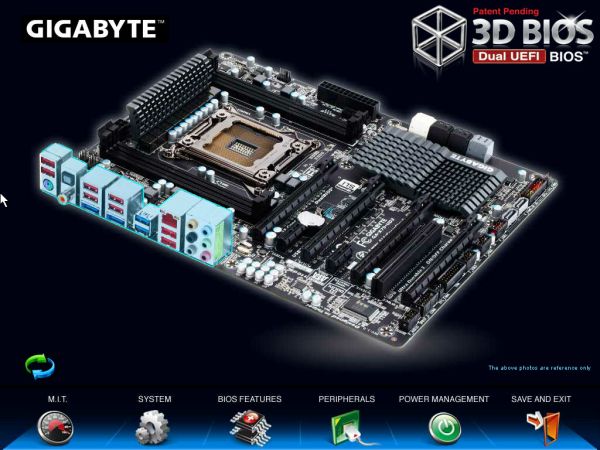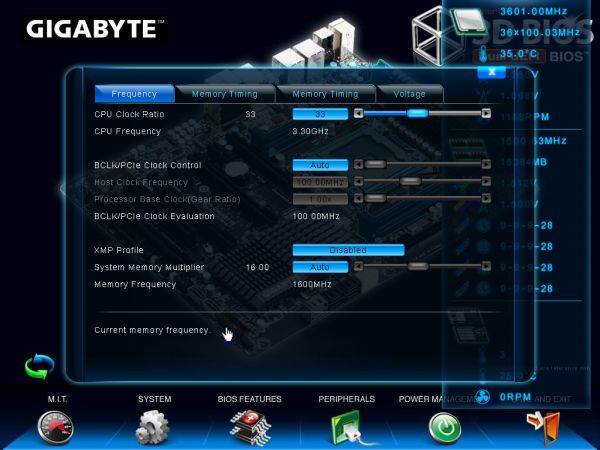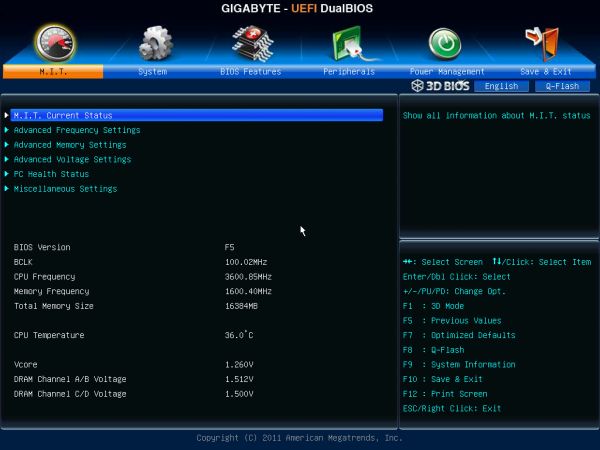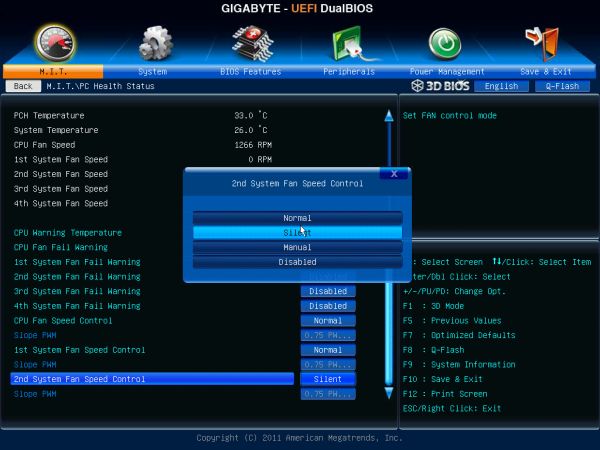Gigabyte GA-X79-UD3 Review
by Ian Cutress on December 26, 2011 4:37 PM EST- Posted in
- Motherboards
- Gigabyte
- X79
- Sandy Bridge E
BIOS
Up until this point, Gigabyte had not released a graphical BIOS for any recent consumer level chipset, if at all. One of the major criticisms of most reviews at the launch of P67 and Sandy Bridge was that while some manufacturers had embraced the zeitgeist of the graphical interface, Gigabyte hadn't, citing that using the old style suited a lot of their customers, and they were able to retain stability of a mature design. So when Anand got a sneak preview from Gigabyte [1,2] , we knew things would change significantly for X79.
Gigabyte call their graphical implementation a '3D BIOS', which to all intents and purposes, isn't 3D at all. The front screen shows the board at an oblique angle (to 'look' 3D), whereby different areas of the board are clickable to see a quick list of certain options.
So for example, if the mouse was moved over the CPU socket, the socket and VRM would turn blue, a little description comes up, and when this is clicked, a screen showing the most obvious BIOS values which can be adjusted. Note, to the right of this is a small list of CPU speed, temperature, voltage, and memory info. In a perfect world, I'd like to see that menu before clicking the board itself. The '3D' board and the menus are all navigable with the keyboard as well, although in 3D mode, the F10 button to save and exit does not do anything, and you will have to navigate to 'Save and Exit' to exit.
By clicking any of the other buttons at the bottom of the screen, we are taken to a more recognizable menu system for a BIOS, with menus and simple selection options.
The main screen is listed as M.I.T., and offers sub menus for the variety of clocking options - frequency, memory, voltage and general health. For the large majority of consumers, the only options worth modifying are the CPU multiplier and the memory divider/XMP profiles. For enthusiasts, there is a wide range of power/PWM controls, current protection modifiers, voltages and sub timings available. I found a couple of things rather frustrating - I really needed one set of options for simple overclocking to be a single menu - CPU Multiplier, Gear Ratio, BCLK, CPU + VTT Voltage, Memory strap, Memory timings, and Memory voltage. I often found myself going in and out of menus to set these - having them all in one menu would be easier to digest.
Fan controls are set in the PC Health Status menu. On the whole, these are ultimately confusing. Only the CPU fan header and the two four-pin fan headers are given adjustment options - either Normal, Silent, Manual or Disabled. In manual mode, the fan speed ramp is adjustable in terms of PWM value / ºC, which in the real world to most people means nothing. The fact that other manufacturers can provide a full range of ramping and selections could either lay at Gigabyte's lack of integration with the fan controllers, or simply they use slightly cheaper ones than some of their competitors. There's scope for improvement here, as a lot of users would prefer a finely grained control over their fans.
By default, users will notice several things: the boot-up Num Lock option is set to disabled, which I found rather odd given that the tendency is to have it enabled. Also, as with other X79 products, we are set to AHCI by default as well, so that users can take advantage of AHCI features. All the boot options are found in the BIOS Features menu, with boot override found in the Save & Exit menu.
Overclocking
For the X79-UD3, overclocking was a little hit and miss. I had trouble with the OC profiles as per the OS software (sometimes it would work), but the CPU overclocking from the BIOS was very easy. The memory overclocking was a one hit wonder however, as for some reason there is a variety of issues. Let us go through them one by one.
For automatic overclocking, we have no options in the BIOS, but in the OS the EasyTune6 software (or via the Smart6 software), there are turbo modes available - either 4.1 GHz, 4.3 GHz or 4.5 GHz (one part of the software says 4.5 GHz, another says 4.68 GHz, but it means 4.5 GHz). By clicking on one, the BIOS is adjusted and the system asks for a reboot to apply the new overclock. Initially, this didn't work for me at all - the software would just crash, or it would reboot with no change. Then, at some random point, it did start to work. By selecting the turbo mode, the speed was correctly selected and it applied the XMP profile of the memory being used. On the 4.5 GHz setting, the board set the peak load voltage to be 1.392 V, and the CPU reached 75ºC during 3DPM. This is a lot better than other vendors' implementations, where they put another 0.1 V into the CPU for equivalent clocks!
In terms of manual overclocks, I purely sat there raising the multiplier. Up to 46x was stable, with the automatic voltage giving 1.392 V. At 47x, the system would BSOD on loading Windows. By going into the BIOS and fixing the voltage at 1.4 V, the board successfully booted and ran, but failed a Blender test. At the 46x setting, a maximum temperature of 78ºC was seen during a Blender test.
For the memory, initially the board was easily able to go into XMP on my new high end G.Skill kit, rated DDR3-2400 9-11-11-31 2T at 1.65 V. The next memory strap was for DDR3-2666, which would not run at 1.65 V even with looser timings (11-14-13). The ability to put it on XMP worked initially over successive reboots, then after a BIOS reset it would not work at all. I tried various combinations, to no avail. Then after a series of resets, it worked again when I applied the automatic overclock setting.
Combined, I believe that if a user can get the 4.5 GHz auto overclock setting to work, which automatically applies the XMP, then we are on to a winner.




















39 Comments
View All Comments
MadMan007 - Monday, December 26, 2011 - link
There are other ways to implement fan control than PWM though, namely voltage control which works with any fan even 2-pin ones with no RPM sensor plus all the 3-pin aftermarket fans. Even if all it did was allow for altrered voltage, or simple software with manual profiles (ie: 'quiet' at a certain voltage' and 'high performance' at another voltage) it would be a big step up from no fan control. Of course that probably costs about $1 in additional parts so god forbid many motherboards have that.In the end it just means having to stick with a real manual fan control but it would be nice to see on motherboards.
gevorg - Wednesday, December 28, 2011 - link
True but not all mobo manufacturers are as cheap as Gigabyte in this regard. Basic P67/Z68 mobos from Intel and Asus/ASRock have case fan controls and some even by PWM.Andrea deluxe - Tuesday, December 27, 2011 - link
http://www.techpowerup.com/157543/Gigabyte-Recalli...Andrea deluxe - Tuesday, December 27, 2011 - link
http://www.youtube.com/watch?v=J_Wk4QWHjpcBrandenburgh Man - Tuesday, December 27, 2011 - link
It's silly to criticize Gigabyte's Multi-Threaded 3D Particle Movement score when the difference between Gigabyte's score of 898.96 and the highest score of 914.36 is less than 2 percent. In the real world, anything less than a 10 percent performance difference is unnoticeable by the user. Typically you have to get 20 to 25 percent better performance before it becomes meaningful to you, and 33 percent or better before you start getting excited about it.wifiwolf - Tuesday, December 27, 2011 - link
If you mean motherboard performance benchmarks are by far less meaningful i agree.That's because this is the less significant part in your system performance-wise, which means 2% difference overall is enough to say it's too much for an high-end.
cactusdog - Tuesday, December 27, 2011 - link
Gigabyte has recalled this board because of a too weak VRM that alows mosfets to explode when overclocking,UD3/ UD5, A1 Assassin all RECALLED by Gigabyte
rumblpak - Tuesday, December 27, 2011 - link
Shouldn't you note that they've all been recalled? Gigabyte announced a worldwide recall of all of their X79 boards.surt - Tuesday, December 27, 2011 - link
Who is buying an x79 and only getting 4 memory slots anyway? That's just crazy. If you want this platform at all, you surely want the large amount of memory it can support. If for nothing else, you can run a nice ramdisk and get things running 10x faster than the best SSD you can buy.Brandenburgh Man - Tuesday, December 27, 2011 - link
I thoroughly agree. SSDs are great for fast boot times and fast program loads, but when you really need *superfast* access to data, nothing beats a RAM drive.Although 4GB DDR3 sticks are dirt cheap right now, four memory slots only comes to 16GB. A six-core hyper-threaded Sandy Bridge E chip would quickly exhaust that if you're a power user who does a lot of video editing or transcoding while simultaneously running other programs. Even if you can afford the currently very expensive 8GB DDR3 sticks, 32GB isn't anything to brag about for a workstation class computer. Better to get a mobo with 8 slots and populate it with 32GB now, then upgrade to 64GB a year or so later when 8GB sticks becine more affordable. Then you'd have the best of both worlds, a huge RAM-disk for incredibly fast I/O, with enough system RAM left over to keep the CPU from being starved.
A few years ago Jerry Pournelle said we were entering the age of computational plenty. I like to say we're entering the age of desktop supercomputing. The future looks very bright indeed.